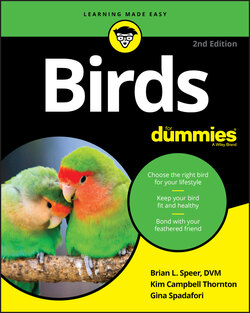Читать книгу Birds For Dummies - Gina Spadafori - Страница 68
Checking Up on a Bird’s Good Health
ОглавлениеIn the wild, a big part of a bird’s survival depends on not presenting a tempting target to predators, who actively seek out the sick, old, and weak. Even in birds who are in little danger from predators — generally safe souls such as our own pet birds — the genetic imperative to hide illness still holds. Some signs of sickness often are visible, however, and you need to look for these tip-offs as you form an overall impression of good health.
A bird can be a big investment, and one of the better ways to protect that investment is to have your new pet thoroughly examined by a veterinarian who is experienced and qualified in the field of avian medicine before your warranty period expires. (You can find more on warranties in the “Protecting Your Rights” section, later in this chapter.)
Any pet bird you consider buying should display the following characteristics:
He behaves normally — perching without problems, moving with coordination, and using his full body without favoring one side or the other. The bird should bear weight evenly, all four toes present on each foot and in proper position — two toes forward, two backward, in the case of parrots.
He’s alert and responsive.
He breathes easily. He should display no sign of laboring to move air and no tail bobbing, which is another indicator of breathing problems.
His eyes, ears, and nostrils (nares) are clean and free of debris and discharge.
His plumage appears healthy. The bird’s feathers should have normal color and structure, showing no signs of stress bars (horizontal lines indicating problems with feather development) or excessive wear. Look for evidence of damage from feather picking, improper housing, or other trauma.
He consistently produces droppings that are normal in appearance. All three components — urine (liquid), feces (solids), and urates (white semi-solids) — should be normal in appearance and quantity. Check for pasting of waste around the fanny. (For the complete scoop on poop, see Chapter 8.)
He has a well-muscled body of appropriate weight, with no signs of obesity. His skin should be smooth and translucent, without excessive amounts of fat showing underneath. You should see no excessive flakiness, scabs, areas of damaged skin, or crustiness.
A bird who’s showing even some of these general signs of illness may be gravely ill and may die even with veterinary intervention. Spare yourself the expense and heartache that bringing home such a bird will entail. Suggest to the seller that the bird needs help, but think twice before taking on the project of nursing the bird yourself.
